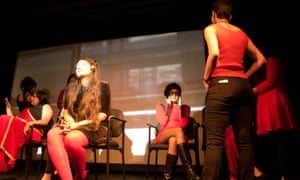
Nadia was sitting by the pool in a bathing suit when a white boy loudly announced how hairy her legs were. She was only 11 years old. As a teenager, her family imposed absurd expectations to maintain an unnatural hairlessness through painful waxing treatments. She would ask why the boys in her community were not shamed in the same way. The Pakistani-Punjabi American woman, wearing a bright red dress and black tights, recounted her childhood atYoni ki Raat (Night of the Vagina) on Friday with a large grin. The endless tribulations of body hair drew knowing laughs from the audience – the double-edged sword of white beauty standards and South Asian gender norms.
But the light atmosphere quickly deserted the theatre as Nadia began to describe how, despite her feminist convictions, she has internalized the compulsive need to remove her hair. Her body is now marred with ingrown hairs that she attempts to dislodge with tweezers and needles, causing further damage to her skin. With her castmates solemnly seated on either side of the stage, a teary-eyed Nadia wondered: “When am I going to stop mutilating myself? Probably never.”
The monologue set the tone for the second annual Yoni ki Raat, a transformational storytelling project performed by 10 South Asian and Indo-Caribbean women in New York City. Performers shared personal narratives on the intersections of sexuality, violence and family that manifest within each of them for two nights over the weekend at Helen Mills Theater.
Woven across overlapping contexts of whiteness, activism and cultural and religious pressures, the show spun colorful and resilient threads of truth into an intricate tapestry of lived realities that are often silenced or ignored.
Yoni ki Raat started building community through storytelling in 2015, inspired by Yoni ki Baat, the Bay Area’s South Asian take on Eve Ensler’s hugely influential play The Vagina Monologues. The show went beyond recitation, as some performers paired their stories with singing, dance, illustration and video. The four-month journey to tap into these layered, deeply rooted narratives began with a process Yumnah Syed called “story excavation”.

No hay comentarios:
Publicar un comentario